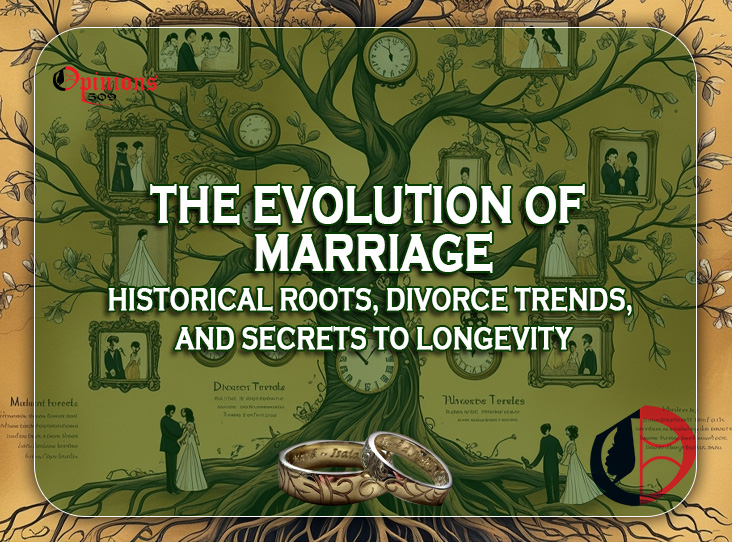Abstract
This research explores the institution of marriage through three lenses: its historical origins, global divorce rate trends, and factors contributing to marital longevity. By examining cultural, legal, and social shifts, the study highlights how marriage has evolved from a pragmatic institution to one emphasizing personal fulfillment, while identifying enduring principles for successful unions.
Table of Contents
1. Historical Origins of Marriage
1.1 Ancient Civilizations
- Mesopotamia: Marriage emerged as a social and economic contract, codified in the Code of Hammurabi (c. 1754 BCE), which outlined property rights and inheritance.
- Egypt: While love was celebrated in poetry, marriage also involved legal agreements, emphasizing companionship and procreation.
- China: Confucian ideals prioritized family harmony, with arranged marriages reinforcing clan alliances.
- India: Vedic rituals like Saptapadi (seven steps) symbolized spiritual unity, blending duty and affection.
1.2 Medieval to Early Modern Europe
- The Catholic Church formalized marriage as a sacrament at the Council of Trent (1563), requiring clergy oversight. This contrasted with earlier informal practices.
1.3 Enlightenment and Modern Shifts
- The 18th-century Enlightenment introduced ideals of individual choice, while industrialization and feminism in the 19th–20th centuries redefined gender roles.
- Legal Milestones: No-fault divorce laws (e.g., California, 1969) and same-sex marriage legalization (Netherlands, 2001; global expansion post-2015) marked profound shifts.
2. Divorce Rates: A Global Perspective
2.1 Historical Context
- Pre-20th Century: Divorce was rare due to stigma and legal barriers (e.g., England’s Matrimonial Causes Act, 1857, allowed divorce only for adultery).
- Post-WWII Surge: U.S. divorce rates spiked in 1946 (14.4 per 1,000 women) as wartime stress dissolved unions.
2.2 Modern Trends
- Peak and Decline: U.S. rates peaked at 5.3 per 1,000 in 1981, falling to 2.5 by 2020. Similar declines occurred in Europe (e.g., Sweden: 2.8 to 1.7).
- Regional Variations:
- Asia: Lower rates (Japan: 1.7) reflect cultural stigma.
- Middle East: Religious norms keep rates low (Egypt: 1.5).
- Factors in Decline: Cohabitation, delayed marriages, and economic independence reduce divorce likelihood.
3. Secrets to Marital Longevity
3.1 Psychological and Relational Factors
Emotional Intimacy: The Heart of Marital Resilience
Emotional intimacy—the ability to share vulnerabilities, fears, and joys without judgment—is a cornerstone of enduring marriages. Unlike physical or social bonds, emotional intimacy requires sustained effort to cultivate trust, mutual understanding, and a shared emotional language. Its role in marital success has been emphasized in psychological research and cross-cultural studies.
Defining Emotional Intimacy
- Vulnerability and Trust: Brené Brown’s research on vulnerability highlights that intimacy thrives when partners courageously share their authentic selves, including insecurities and imperfections. Trust is built through consistent, non-judgmental responses to such disclosures.
- Emotional Attunement: Psychologist John Gottman identifies “emotional bids” (e.g., a partner sharing a story or seeking comfort) as critical moments. Couples who consistently respond with empathy (“turning toward”) strengthen intimacy, while neglect (“turning away”) erodes it.
- Shared Meaning Systems: Partners who create rituals (e.g., daily check-ins) or shared goals (e.g., parenting philosophies) develop a narrative of “we-ness,” reinforcing emotional cohesion.
Mechanisms for Building Emotional Intimacy
- Active Listening:
- Techniques like reflective listening (“It sounds like you’re feeling overwhelmed”) validate emotions.
- Avoiding problem-solving during emotional disclosures (e.g., “Let me just listen first”) fosters safety.
- Empathy in Action:
- Neuroimaging studies show that empathy activates brain regions linked to emotional connection (e.g., the anterior insula). Practicing empathy—even during conflicts—reduces defensiveness.
- Example: A 2020 study in Journal of Marriage and Family found couples who used “I feel” statements (vs. accusatory “You” statements) reported higher intimacy.
- Conflict as Connection:
- Healthy couples view disagreements as opportunities to understand each other’s perspectives. Gottman’s “repair attempts” (e.g., humor or apologies) prevent conflicts from escalating.
- Example: A partner saying, “I need a moment, but I still care about us,” de-escalates tension.
- Shared Vulnerability:
- Activities like reminiscing about challenges (e.g., “Remember when we struggled with infertility?”) or expressing gratitude (“I admire how you handled that”) deepen bonds.
Cultural Variations in Emotional Intimacy
- Western Individualism: In societies prioritizing romantic love (e.g., the U.S.), emotional intimacy is often linked to self-disclosure and verbal affirmation.
- Collectivist Cultures: In Japan or India, intimacy may manifest through acts of service (e.g., preparing meals) or silent understanding (ishin-denshin), emphasizing harmony over explicit communication.
- Gender Norms: Traditional societies may discourage male vulnerability, limiting emotional expression. However, modern shifts (e.g., South Korea’s “soft masculinity” trends) are redefining norms.
Challenges to Emotional Intimacy
- Technology Distraction: A 2023 Pew Research study found 45% of couples report smartphones interfering with quality time.
- Stress and External Pressures: Financial strain or parenting demands can deprioritize intimacy.
- Unresolved Trauma: Childhood attachment styles (e.g., avoidant or anxious) influence adult intimacy. Therapy (e.g., Emotionally Focused Therapy) can address these patterns.
Strategies for Sustaining Intimacy
- Scheduled Check-Ins: Weekly “state of the union” conversations to discuss feelings and needs.
- Novelty and Play: Shared hobbies or travel reignite emotional connection by creating new memories.
- Mindfulness Practices: Couples meditation or gratitude journals enhance present-moment attunement.
Integration with Marital Longevity
Emotional intimacy acts as a buffer against marital decay. A 2021 longitudinal study in Developmental Psychology found that couples prioritizing emotional connection had a 30% lower divorce rate over 15 years. In contrast, marriages lacking intimacy often dissolve even without overt conflict—a phenomenon termed “walkaway wife syndrome” in high-stress partnerships.
Modern therapy frameworks, such as the Gottman Method or Imago Therapy, now prioritize intimacy-building exercises, reflecting its centrality to marital success. Meanwhile, cultural shifts toward gender equality and emotional literacy are reshaping intimacy norms globally, enabling more couples to balance autonomy with interdependence.
3.2 Structural and Cultural Elements
- Adaptability: Flexibility in roles (e.g., dual-income households) helps navigate life transitions.
- Shared Values: Alignment on finances, parenting, and life goals reduces friction.
- Support Systems: Extended family (e.g., India’s joint families) or community networks provide stability.
3.3 Cultural Case Studies
- Japan: Emphasis on gaman (perseverance) and mutual respect.
- Scandinavia: Gender equality correlates with marital satisfaction.
4. Conclusion
Marriage has transitioned from a socio-economic institution to one centered on personal fulfillment, yet its success hinges on timeless principles: communication, adaptability, and shared purpose. While divorce rates reflect changing norms, the decline in Western nations suggests a recalibration rather than rejection of marriage. Cultural contexts continue to shape marital dynamics, underscoring the need for policies supporting relationship education and work-life balance.
Keywords: Marriage history, divorce trends, marital longevity, communication, cultural norms.
References
- Coontz, S. (2005). Marriage, a History: How Love Conquered Marriage.
- Gottman, J. (1999). The Seven Principles for Making Marriage Work.
- UN World Marriage Data (2023).
- Pew Research Center (2020). The Changing Profile of Unmarried Parents.
- Brown, B. (2012). Daring Greatly: How the Courage to Be Vulnerable Transforms the Way We Live, Love, Parent, and Lead.
- Feeney, J. A. (2020). “Empathic Communication in Marital Conflict: A Pathway to Intimacy.” Journal of Marriage and Family.
- Pew Research Center (2023). How Couples Navigate Digital Distractions in Relationships.
This synthesis of historical, statistical, and psychological insights offers a comprehensive understanding of marriage’s past, present, and future.
Author
Stay connected for new publications, events, and more.







More Stories
Le pape Léon XIV : un pontife historique qui jette un pont entre les continents et les cultures
What Happens When a Pope Dies
Le Prix de la Liberté : 17 Avril 1825, une Ordonnance Injuste. Déclaration de Macron